Effects of Cerebrospinal Fluids from Alzheimer and Non-Alzheimer Patients on Neurons–Astrocytes–Microglia Co-Culture
Abstract
1. Introduction
2. Results
2.1. Effects of CSF from AD and Non-AD Patients on NAM Co-Culture
2.2. Gelatinolytic Activities and Their Quantification in CM and Cell Extracts from NAM Co-Cultures Treated or Not with CSF
2.3. Immunofluorescence Staining Using Different Antigens on NAM Co-Cultures Treated with CSF from AD (Aβ+Tau and Aβ-Tau), Non-AD (Non-AD), and PBS (Control) Subjects
2.4. Quantitative PCR Performed on NAM Co-Cultures Treated with CSF from AD (Aβ+Tau and Aβ-Tau) and Non-AD (Non-AD) Subjects at 24 h and 48 h, Respectively
3. Discussion
4. Materials and Methods
4.1. CSF Sample
4.2. Evaluations of Aβ 1–42, Aβ 1–40, Aβ 42/40 Ratio, Tau-Total, Tau-Phosphorylated, and CX3CL1 in Selected CSF Were Performed via Chemioluminescence Enzyme Immunoassay (CLEIA) and ELISA in the Selected Groups of Aβ+Tau, Aβ-Tau, and Non-AD Patients
4.3. NAM Co-Cultures
4.4. Morphological Assay
4.5. Immunofluorescence (IF) Assays
4.6. Extraction of Soluble Proteins from NAM Co-Culture Cells
4.7. Zymography Assay
4.8. RNA Isolation and cDNA Synthesis
4.9. RT-qPCR
4.10. Densitometry Evaluation of Protein Expression
4.11. Statistical Analyses
Supplementary Materials
Author Contributions
Funding
Institutional Review Board Statement
Informed Consent Statement
Data Availability Statement
Conflicts of Interest
References
- Jiang, S.; Bhaskar, K. Dynamics of the Complement, Cytokine, and Chemokine Systems in the Regulation of Synaptic Function and Dysfunction Relevant to Alzheimer’s Disease. J. Alzheimers Dis. 2017, 57, 1123–1135. [Google Scholar] [CrossRef] [PubMed]
- Harrison, J.K.; Jiang, Y.; Chen, S.; Xia, Y.; Maciejewski, D.; Mcnamara, R.K.; Streit, W.J.; Salafranca, M.N.; Adhikari, S.; Thompson, D.A.; et al. Role for Neuronally Derived Fractalkine in Mediating Interactions between Neurons and CX3CR1-Expressing Microglia. Proc. Natl. Acad. Sci. USA 1998, 95, 10896–10901. [Google Scholar] [CrossRef] [PubMed]
- Schafer, D.P.; Lehrman, E.K.; Kautzman, A.G.; Koyama, R.; Mardinly, A.R.; Yamasaki, R.; Ransohoff, R.M.; Greenberg, M.E.; Barres, B.A.; Stevens, B. Microglia Sculpt Postnatal Neural Circuits in an Activity and Complement-Dependent Manner. Neuron 2012, 74, 691–705. [Google Scholar] [CrossRef] [PubMed]
- Bhaskar, K.; Konerth, M.; Kokiko-Cochran, O.N.; Cardona, A.; Ransohoff, R.M.; Lamb, B.T. Regulation of Tau Pathology by the Microglial Fractalkine Receptor. Neuron 2010, 68, 19–31. [Google Scholar] [CrossRef]
- Bolós, M.; Llorens-Martín, M.; Perea, J.R.; Jurado-Arjona, J.; Rábano, A.; Hernández, F.; Avila, J. Absence of CX3CR1 Impairs the Internalization of Tau by Microglia. Mol. Neurodegener. 2017, 12, 59. [Google Scholar] [CrossRef]
- Guedes, J.R.; Lao, T.; Cardoso, A.L.; El Khoury, J. Roles of Microglial and Monocyte Chemokines and Their Receptors in Regulating Alzheimer’s Disease-Associated Amyloid-β and Tau Pathologies. Front. Neurol. 2018, 9, 549. [Google Scholar] [CrossRef]
- Munoz, L.; Ammit, A.J. Targeting P38 MAPK Pathway for the Treatment of Alzheimer’s Disease. Neuropharmacology 2010, 58, 561–568. [Google Scholar] [CrossRef]
- Kheiri, G.; Dolatshahi, M.; Rahmani, F.; Rezaei, N. Role of P38/MAPKs in Alzheimer’s Disease: Implications for Amyloid Beta Toxicity Targeted Therapy. Rev. Neurosci. 2019, 30, 9–30. [Google Scholar] [CrossRef]
- Jia, L.; Piña-Crespo, J.; Li, Y. Restoring Wnt/β-Catenin Signaling Is a Promising Therapeutic Strategy for Alzheimer’s Disease. Mol. Brain 2019, 12, 104. [Google Scholar] [CrossRef]
- Shi, Z.M.; Han, Y.W.; Han, X.H.; Zhang, K.; Chang, Y.N.; Hu, Z.M.; Qi, H.X.; Ting, C.; Zhen, Z.; Hong, W. Upstream Regulators and Downstream Effectors of NF-ΚB in Alzheimer’s Disease. J. Neurol. Sci. 2016, 366, 127–134. [Google Scholar] [CrossRef]
- Ju Hwang, C.; Choi, D.-Y.; Park, M.H.; Hong, J.T. NF-ΚB as a Key Mediator of Brain Inflammation in Alzheimer’s Disease. CNS Neurol. Disord.-Drug Targets 2017, 18, 3–10. [Google Scholar] [CrossRef]
- Qian, M.; Shen, X.; Wang, H. The Distinct Role of ADAM17 in APP Proteolysis and Microglial Activation Related to Alzheimer’s Disease. Cell. Mol. Neurobiol. 2016, 36, 471–482. [Google Scholar] [CrossRef] [PubMed]
- Gooz, M. ADAM-17: The Enzyme That Does It All. Crit. Rev. Biochem. Mol. Biol. 2010, 45, 146–169. [Google Scholar] [CrossRef] [PubMed]
- Kim, M.; Suh, J.; Romano, D.; Truong, M.H.; Mullin, K.; Hooli, B.; Norton, D.; Tesco, G.; Elliott, K.; Wagner, S.L.; et al. Potential Late-Onset Alzheimer’s Disease-Associated Mutations in the ADAM10 Gene Attenuate α-Secretase Activity. Hum. Mol. Genet. 2009, 18, 3987–3996. [Google Scholar] [CrossRef] [PubMed]
- Postina, R.; Schroeder, A.; Dewachter, I.; Bohl, J.; Schmitt, U.; Kojro, E.; Prinzen, C.; Endres, K.; Hiemke, C.; Blessing, M.; et al. A Disintegrin-Metalloproteinase Prevents Amyloid Plaque Formation and Hippocampal Defects in an Alzheimer Disease Mouse Model. J. Clin. Investig. 2004, 113, 1456–1464. [Google Scholar] [CrossRef] [PubMed]
- De Strooper, B.; Annaert, W.; Cupers, P.; Saftig, P.; Craessaerts, K.; Mumm, J.S.; Schroeter, E.H.; Schrijvers, V.; Wolfe, M.S.; Ray, W.J.; et al. A Presenilin-1-Dependent γ-Secretase-like Protease Mediates Release of Notch Intracellular Domain. Nature 1999, 398, 6727. [Google Scholar] [CrossRef] [PubMed]
- Bivona, G.; Iemmolo, M.; Piccoli, T.; Agnello, L.; Lo Sasso, B.; Ciaccio, M.; Ghersi, G. High Cerebrospinal Fluid CX3CL1 Levels in Alzheimer’s Disease Patients but Not in Non-Alzheimer’s Disease Dementia. J. Clin. Med. 2022, 11, 5498. [Google Scholar] [CrossRef] [PubMed]
- Walters, A.; Phillips, E.; Zheng, R.; Biju, M.; Kuruvilla, T. Evidence for Neuroinflammation in Alzheimer’s Disease. Prog. Neurol. Psychiatry 2016, 20, 25–31. [Google Scholar] [CrossRef]
- Kinney, J.W.; Bemiller, S.M.; Murtishaw, A.S.; Leisgang, A.M.; Salazar, A.M.; Lamb, B.T. Inflammation as a Central Mechanism in Alzheimer’s Disease. Alzheimers Dementia Transl. Res. Clin. Interv. 2018, 4, 575. [Google Scholar] [CrossRef]
- Porro, C.; Cianciulli, A.; Panaro, M.A. The Regulatory Role of IL-10 in Neurodegenerative Diseases. Biomolecules 2020, 10, 1017. [Google Scholar] [CrossRef]
- Parr, C.; Mirzaei, N.; Christian, M.; Sastre, M. Activation of the Wnt/β-Catenin Pathway Represses the Transcription of the β-Amyloid Precursor Protein Cleaving Enzyme (BACE1) via Binding of T-Cell Factor-4 to BACE1 Promoter. FASEB J. 2015, 29, 623–635. [Google Scholar] [CrossRef]
- Tapia-Rojas, C.; Burgos, P.V.; Inestrosa, N.C. Inhibition of Wnt Signaling Induces Amyloidogenic Processing of Amyloid Precursor Protein and the Production and Aggregation of Amyloid-β (Aβ)42 Peptides. J. Neurochem. 2016, 139, 1175–1191. [Google Scholar] [CrossRef] [PubMed]
- Scali, C.; Caraci, F.; Gianfriddo, M.; Diodato, E.; Roncarati, R.; Pollio, G.; Gaviraghi, G.; Copani, A.; Nicoletti, F.; Terstappen, G.C.; et al. Inhibition of Wnt Signaling, Modulation of Tau Phosphorylation and Induction of Neuronal Cell Death by DKK1. Neurobiol. Dis. 2006, 24, 254–265. [Google Scholar] [CrossRef] [PubMed]
- Caricasole, A.; Copani, A.; Caraci, F.; Aronica, E.; Rozemuller, A.J.; Caruso, A.; Storto, M.; Gaviraghi, G.; Terstappen, G.C.; Nicoletti, F. Induction of Dickkopf-1, a Negative Modulator of the Wnt Pathway, Is Associated with Neuronal Degeneration in Alzheimer’s Brain. J. Neurosci. 2004, 24, 6021. [Google Scholar] [CrossRef] [PubMed]
- Boyce, J.J.; Shea, T.B. Phosphorylation Events Mediated by Protein Kinase Cα and ε Participate in Regulation of Tau Steady-State Levels and Generation of Certain “Alzheimer-like” Phospho-Epitopes. Int. J. Dev. Neurosci. 1997, 15, 295–307. [Google Scholar] [CrossRef] [PubMed]
- Shukla, V.; Skuntz, S.; Pant, H.C. Deregulated Cdk5 Activity Is Involved in Inducing Alzheimer’s Disease. Arch. Med. Res. 2012, 43, 655. [Google Scholar] [CrossRef]
- Hampel, H.; Hardy, J.; Blennow, K.; Chen, C.; Perry, G.; Kim, S.H.; Villemagne, V.L.; Aisen, P.; Vendruscolo, M.; Iwatsubo, T.; et al. The Amyloid-β Pathway in Alzheimer’s Disease. Mol. Psychiatry 2021, 26, 5481. [Google Scholar] [CrossRef] [PubMed]
- Roher, A.E.; Kasunic, T.C.; Woods, A.S.; Cotter, R.J.; Ball, M.J.; Fridman, R. Proteolysis of Aβ Peptide from Alzheimer Disease Brain by Gelatinase A. Biochem. Biophys. Res. Commun. 1994, 205, 1755–1761. [Google Scholar] [CrossRef] [PubMed]
- Backstrom, J.R.; Lim, G.P.; Cullen, M.J.; Tökés, Z.A. Matrix Metalloproteinase-9 (MMP-9) Is Synthesized in Neurons of the Human Hippocampus and Is Capable of Degrading the Amyloid-β Peptide (1–40). J. Neurosci. 1996, 16, 7910–7919. [Google Scholar] [CrossRef]
- Yan, P.; Hu, X.; Song, H.; Yin, K.; Bateman, R.J.; Cirrito, J.R.; Xiao, Q.; Hsu, F.F.; Turk, J.W.; Xu, J.; et al. Matrix Metalloproteinase-9 Degrades Amyloid-β Fibrils in Vitro and Compact Plaques in Situ. J. Biol. Chem. 2006, 281, 24566–24574. [Google Scholar] [CrossRef]
- Yin, K.-J.; Cirrito, J.R.; Yan, P.; Hu, X.; Xiao, Q.; Pan, X.; Bateman, R.; Song, H.; Hsu, F.-F.; Turk, J.; et al. Neurobiology of Disease Matrix Metalloproteinases Expressed by Astrocytes Mediate Extracellular Amyloid-Peptide Catabolism. J. Neurosci. 2006, 26, 10939–10948. [Google Scholar] [CrossRef]
- Hernandez-Guillamon, M.; Mawhirt, S.; Blais, S.; Montaner, J.; Neubert, T.A.; Rostagno, A.; Ghiso, J. Sequential Amyloid-Degradation by the Matrix Metalloproteases MMP-2 and MMP-9 *. J. Biol. Chem. 2015, 290, 15078–15091. [Google Scholar] [CrossRef] [PubMed]
- Salamone, M.; Carfì Pavia, F.; Ghersi, G. Proteolytic Enzymes Clustered in Specialized Plasma-Membrane Domains Drive Endothelial Cells’ Migration. PLoS ONE 2016, 11, e0154709. [Google Scholar] [CrossRef]
- Morris, J.C. Clinical Dementia Rating: A Reliable and Valid Diagnostic and Staging Measure for Dementia of the Alzheimer Type. Int. Psychogeriatr. 1997, 9, 173–176. [Google Scholar] [CrossRef] [PubMed]
- Bohnen, N.I.; Djang, D.S.W.; Herholz, K.; Anzai, Y.; Minoshima, S. Effectiveness and Safety of 18F-FDG PET in the Evaluation of Dementia: A Review of the Recent Literature. J. Nucl. Med. 2012, 53, 59–71. [Google Scholar] [CrossRef] [PubMed]
- Del Campo, M.; Mollenhauer, B.; Bertolotto, A.; Engelborghs, S.; Hampel, H.; Simonsen, A.H.; Kapaki, E.; Kruse, N.; Le Bastard, N.; Lehmann, S.; et al. Recommendations to Standardize Preanalytical Confounding Factors in Alzheimer’s and Parkinson’s Disease Cerebrospinal Fluid Biomarkers: An Update. Biomark. Med. 2012, 6, 419–430. [Google Scholar] [CrossRef]
- Schiera, G.; Bono, E.; Raffa, M.P.; Gallo, A.; Pitarresi, G.L.; Di Liegro, I.; Savettieri, G. Synergistic Effects of Neurons and Astrocytes on the Differentiation of Brain Capillary Endothelial Cells in Culture. J. Cell. Mol. Med. 2003, 7, 165. [Google Scholar] [CrossRef] [PubMed]
- Caradonna, F.; Schiera, G.; Di Liegro, C.M.; Vitale, V.; Cruciata, I.; Ferrara, T.; D’oca, P.; Mormino, R.; Maria, S.; Rizzo, A.; et al. Establishment and Preliminary Characterization of Three Astrocytic Cells Lines Obtained from Primary Rat Astrocytes by Sub-Cloning. Genes 2020, 11, 1502. [Google Scholar] [CrossRef]
- Schiera, G.; Sala, S.; Gallo, A.; Raffa, M.P.; Pitarresi, G.L.; Savettieri, G.; Di Liegro, I. Permeability Properties of a Three-cell Type in Vitro Model of Blood-brain Barrier. J. Cell. Mol. Med. 2005, 9, 373. [Google Scholar] [CrossRef]
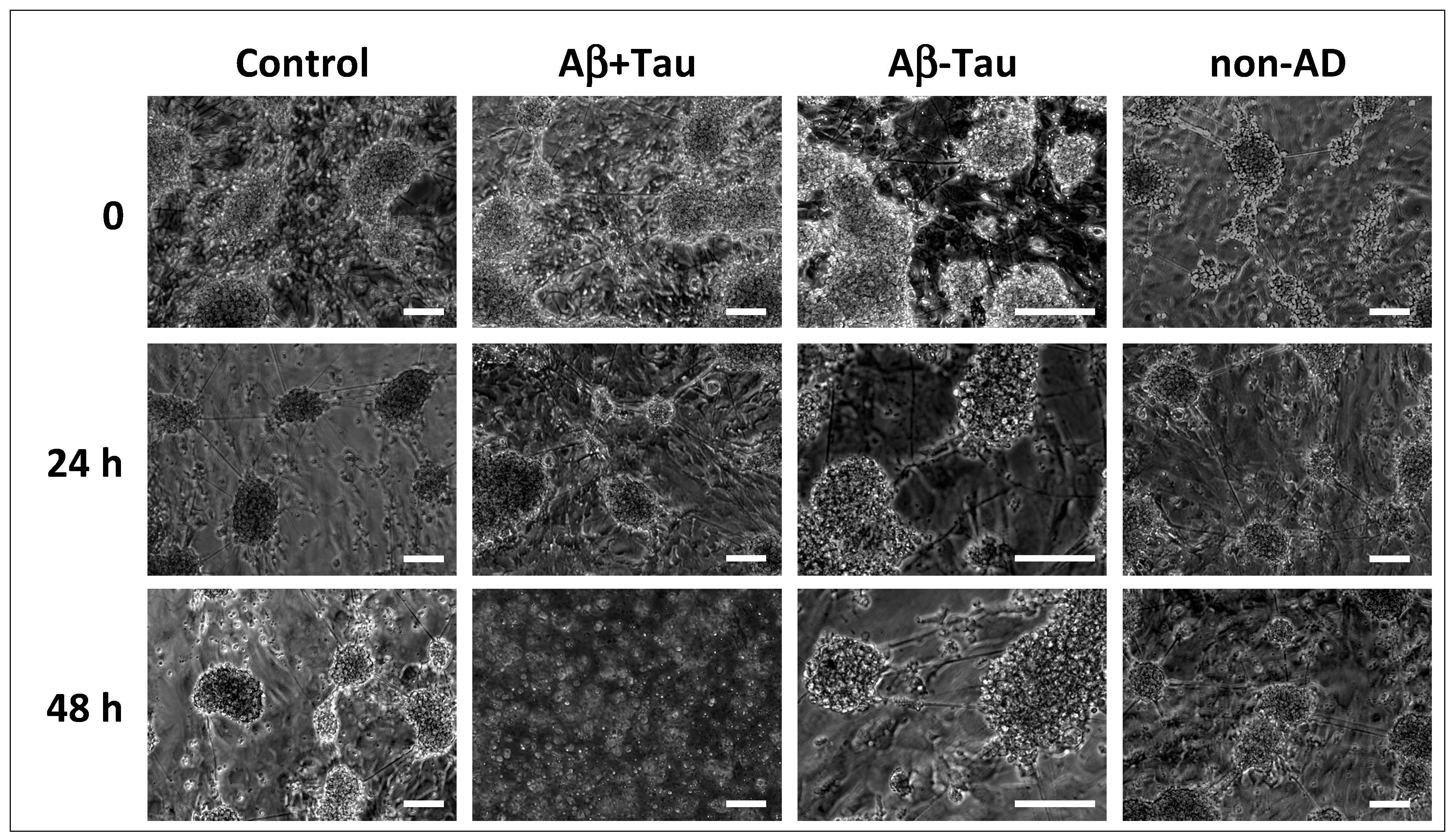
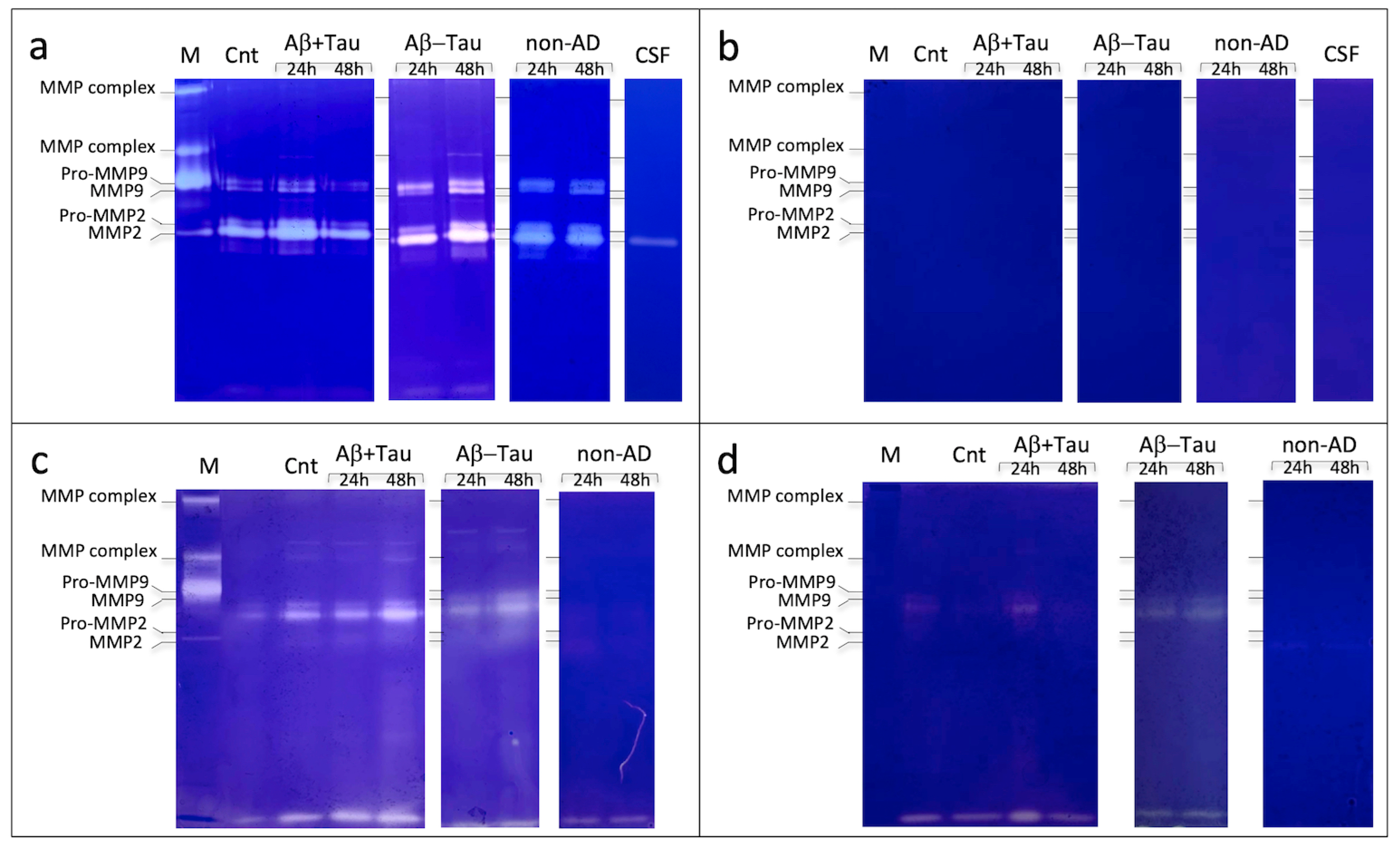
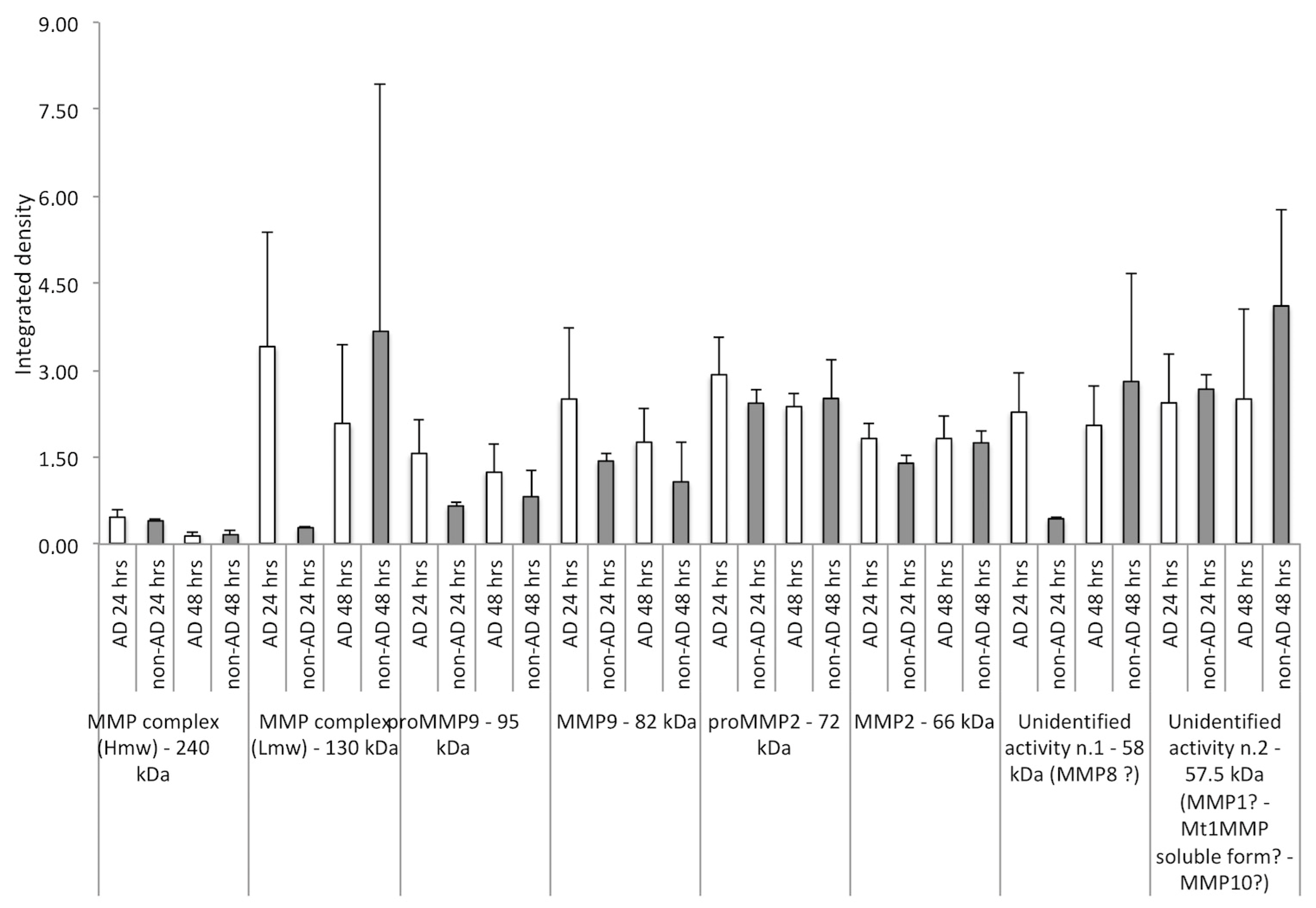
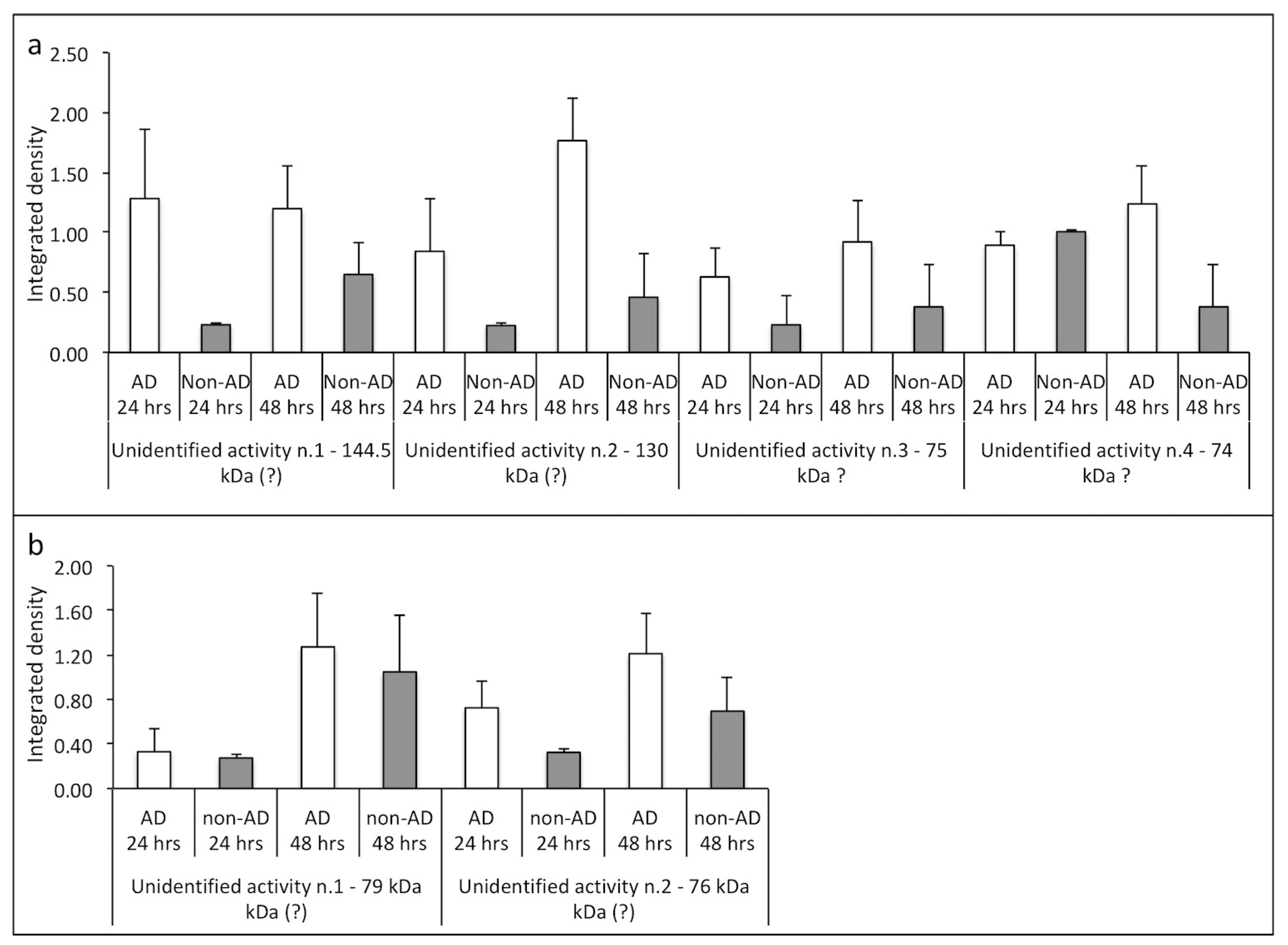
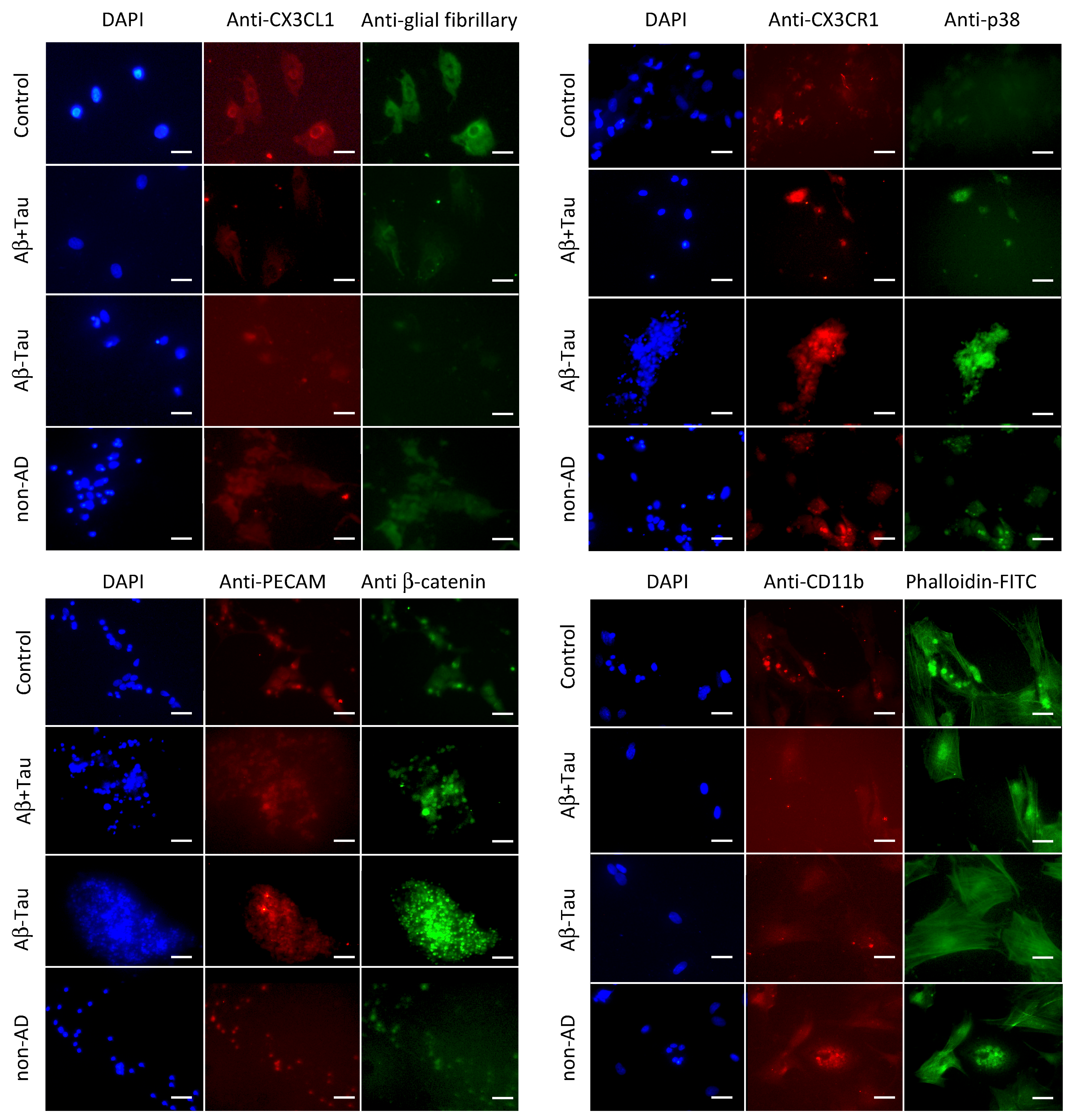
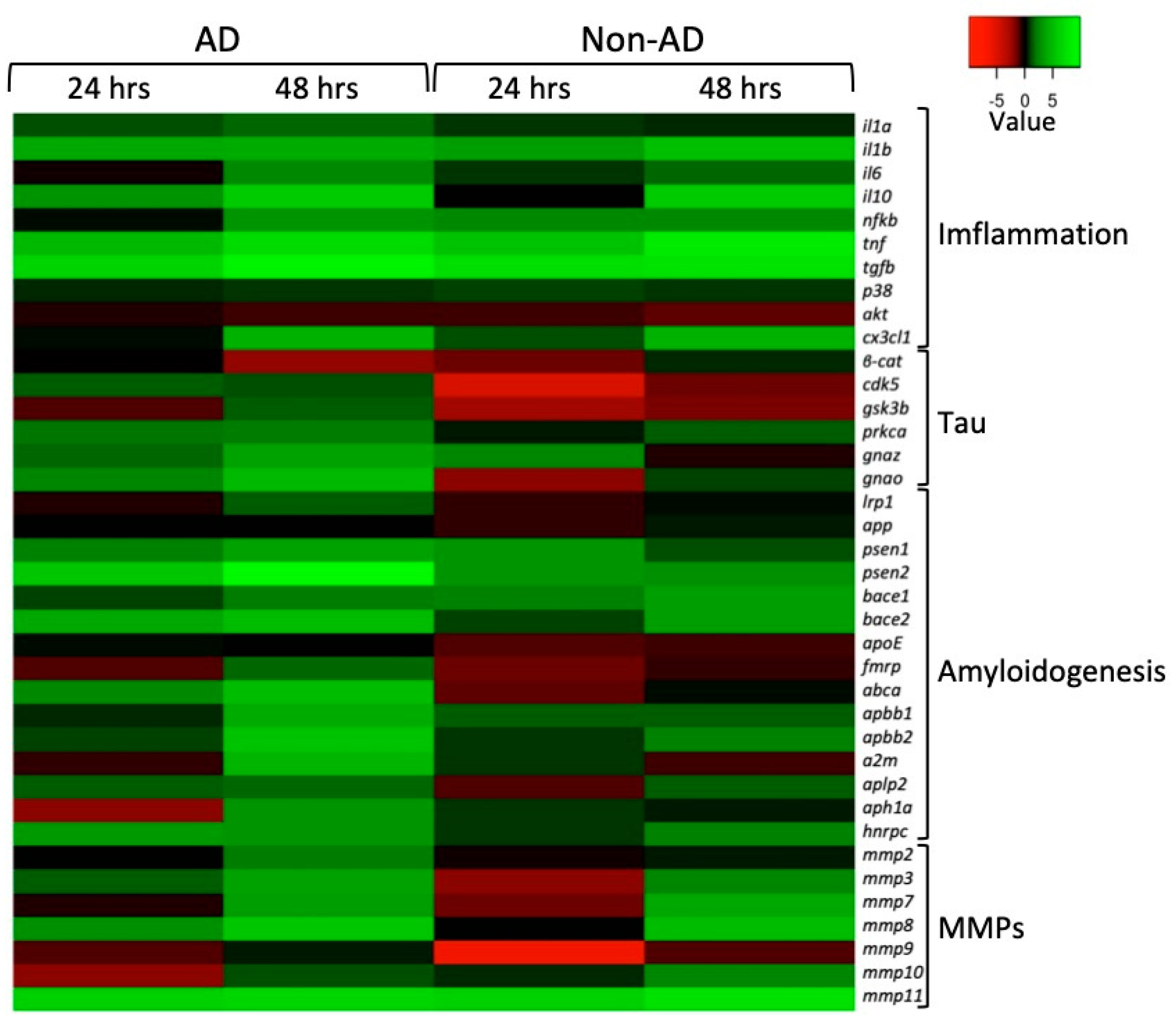

| Variable | Patients Tot (n = 12) | Group Aβ+Tau (n = 4) | Group Aβ-Tau (n = 4) | Group Non-AD (n = 4) | σ2 * |
|---|---|---|---|---|---|
| Aβ 1–42 (pg/mL) | 705.33 (402–1479) | 507.75 (486–520) | 455.50 (402–559) | 1152.75 (979–1479) | 0.47 |
| Aβ 1–40 (pg/mL) | 11,236.67 (6840–16,029) | 16,029 (10,651–16,029) | 8517.25 (6840–10,907) | 12,070 (10,701–14,490) | 0.19 |
| Aβ 42/40 ratio | 0.06 (0.03–0.11) | 0.04 (0.03–0.05) | 0.06 (0.05–0.06) | 0.95 (0.08–0.11) | 0.34 |
| Tau-total | 406.83 (158–711) | 635.50 (557–711) | 331.25 (255–380) | 253.75 (158–302) | 0.35 |
| Tau-phosphorylated (181) | 56.92 (27–91) | 95.50 (82–125) | 46.33 (41–50) | 28.92 (27–30) | 0.48 |
| CX3CL1 | 0.45 (0.28–0.68) | 0.52 (0.41–0.68) | 0.55 (0.47–0.63) | 0.30 (0.28–0.32) | 0.26 |
| Control | Aβ+Tau | Aβ-Tau | Non-AD | ||
|---|---|---|---|---|---|
| 0 | n. neurospheres | 6 ± 2 | 8 ± 3 | 9 ± 3 | 7 ± 2 |
| Surface mm2 | ≈23 ± 2.2 | ≈44 ± 1.3 | ≈69 ± 6.8 | ≈19 ± 1.7 | |
| 24 h | n. neurospheres | 6 ± 2 | 7 ± 2 | 10 ± 3 | 6 ± 1 |
| Surface mm2 | ≈35 ± 1.5 | ≈31 ± 6.0 | ≈79 ± 13.3 | ≈31 ± 1.9 | |
| 48 h | n. neurospheres | 7 ± 2 | 1 ± 2 | 7 ± 2 | 7 ± 2 |
| Surface mm2 | ≈37 ± 1.4 | ≈0.14 ± 0.3 | ≈86 ± 22.6 | ≈24 ± 1.4 |
| AD 24 h | AD 48 h | Non-AD 24 h | Non-AD 48 h | Control | ||
|---|---|---|---|---|---|---|
| MMP complex (hmw) | Median value | 7014 | 45,664 | 13,862 | 10,718 | 37,172 |
| Median control/Median group value | 5.30 | 0.81 | 2.02 | 3.47 | ||
| p-value | 6.72 × 10−2 | 4.63 × 10−5 | 3.11 × 10−5 | 6.59 × 10−2 | ||
| * H0 | NRH0 | RH0 | RH0 | NRH0 | ||
| MMP complex (lmw) | Median value | 200,709 | 16,995 | 5864 | 176,448 | 23,771 |
| Median control/Median group value | 0.12 | 1.40 | 4.05 | 0.13 | ||
| p-value | 1.41 × 10−4 | 2.59 × 10−2 | 1.44 × 10−2 | 7.21 × 10−3 | ||
| * H0 | RH0 | NRH0 | RH0 | RH0 | ||
| Pro-MMP9 | Median value | 200,709 | 533,356 | 1,224,000 | 2,261,163 | 494,851 |
| Median control/Median group value | 2.47 | 0.93 | 0.40 | 0.22 | ||
| p-value | 8.39 × 10−2 | 6.60 × 10−2 | 3.68 × 10−2 | 1.61 × 10−4 | ||
| * H0 | NRH0 | NRH0 | RH0 | RH0 | ||
| MMP9 | Median value | 1,524,560 | 420,993 | 1,823,910 | 1,099,278 | 954,958 |
| Median control/Median group value | 0.63 | 2.27 | 0.52 | 0.87 | ||
| p-value | 2.56 × 10−2 | 4.26 × 10−2 | 4.96 × 10−3 | 7.79 × 10−4 | ||
| * H0 | RH0 | RH0 | RH0 | RH0 | ||
| Pro-MMP2 | Median value | 85,105 | 26,260 | 4565 | 43,553 | 21,707 |
| Median control/Median group value | 0.26 | 0.83 | 4.76 | 0.50 | ||
| p-value | 2.92 × 10−2 | 4.07 × 10−2 | 3.95 × 10−4 | 2.03 × 10−3 | ||
| * H0 | RH0 | RH0 | RH0 | RH0 | ||
| MMP2 | Median value | 2,374,832 | 1,074,324 | 1,620,570 | 1,973,878 | 889,265 |
| Median control/Median group value | 0.37 | 0.83 | 0.55 | 0.45 | ||
| p-value | 1.28 × 10−5 | 1.57 × 10−6 | 2.45 × 10−2 | 3.01 × 10−6 | ||
| * H0 | RH0 | RH0 | RH0 | RH0 | ||
| Unidentified n.1 | Median value | 9,138,799 | 6,588,153 | 5,562,824 | 6,376,780 | 4,500,691 |
| Median control/Median group value | 0.49 | 0.68 | 0.81 | 0.71 | ||
| p-value | 5.91 × 10−2 | 5.20 × 10−2 | 3.15 × 10−2 | 9.95 × 10−3 | ||
| * H0 | NRH0 | NRH0 | RH0 | RH0 | ||
| Unidentified n.2 | Median value | 340,872 | 88,358 | 193,501 | 251,461 | 77,672 |
| Median control/Median group value | 0.23 | 0.88 | 0.40 | 0.31 | ||
| p-value | 4.13 × 10−2 | 4.16 × 10−2 | 3.75 × 10−2 | 1.22 × 10−2 | ||
| * H0 | RH0 | RH0 | RH0 | RH0 |
| AD 24 h | AD 48 h | Non-AD 24 h | Non-AD 48 h | Control | ||
|---|---|---|---|---|---|---|
| Unidentified n.1 in Ext. + Ca2+ | Median value | 43,562 | 63,854 | 67,741 | 56,330 | 51,098 |
| Median control/Median group value | 1.17 | 0.80 | 0.75 | 0.91 | ||
| p-value | 2.28 × 10−2 | 3.72 × 10−2 | 4.76 × 10−5 | 4.17 × 10−2 | ||
| * H0 | RH0 | RH0 | RH0 | RH0 | ||
| Unidentified n.2 in Ext. + Ca2+ | Median value | 77,405 | 137,758 | 2808 | 11,558 | 62,219 |
| Median control/Median group value | 0.80 | 0.45 | 22.16 | 5.38 | ||
| p-value | 3.12 × 10−2 | 4.96 × 10−1 | 3.09 × 10−1 | 0.90 × 10−2 | ||
| * H0 | RH0 | NRH0 | NRH0 | NRH0 | ||
| Unidentified n.3 in Ext. + Ca2+ | Median value | 200,709 | 533,356 | 1,224,000 | 2,261,163 | 645,695 |
| Median control/Median group value | 3.22 | 1.21 | 0.53 | 0.29 | ||
| p-value | 1.27 × 10−6 | 9.04 × 10−4 | 5.55 × 10−3 | 5.60 × 10−2 | ||
| * H0 | RH0 | RH0 | RH0 | NRH0 | ||
| Unidentified n.4 in Ext. + Ca2+ | Median value | 1,667,101 | 1,920,203 | 829,256 | 1,072,515 | 1,420,225 |
| Median control/Median group value | 0.85 | 0.74 | 1.72 | 1.32 | ||
| p-value | 1.54 × 10−2 | 9.84 × 10−2 | 1.79 × 10−2 | 2.83 × 10−2 | ||
| * H0 | RH0 | NRH0 | RH0 | RH0 | ||
| Unidentified n.1 in Ext. + EDTA | Median value | 85,105 | 26,260 | 4565 | 4355 | 359,557 |
| Median control/Median group value | 4.22 | 13.69 | 78,77 | 8,26 | ||
| p-value | 2.92 × 10−2 | 4.07 × 10−2 | 3.95 × 10−4 | 2.03 × 10−3 | ||
| * H0 | RH0 | RH0 | RH0 | RH0 | ||
| Unidentified n.2 in Ext. + EDTA | Median value | 1,733,179 | 1,778,225 | 495,814 | 1733,189 | 1,549,198 |
| Median control/Median group value | 0.89 | 0.87 | 3.12 | 0.89 | ||
| p-value | 4.23 × 10−2 | 6.54 × 10−3 | 2.21 × 10−3 | 4.23 × 10−2 | ||
| * H0 | RH0 | RH0 | RH0 | RH0 |
| Gene | Forward | Reverse |
|---|---|---|
| Gadph | 5′-CAACTCCCTCAAGATTGTCAGCAA-3 | 5-′GGCATGGACTGTGGTCATGA-3 |
| Bace1 | CCGAGACCTCCGAAAGTCTG | GTGATGGCAGCAATGTTGG |
| Bace2 | CGAACCACAGAGCCTCAACTG | GAGTCCCCCTGAAGATTGTCC |
| Psen1 | AGCGTCCGTAGCCAGAATG | CGTCTTCCTCCTCATCTTGC |
| Psen2 | CGGAGGAGGAGGAGGAAAG | GCAGGAGGGTGAGACACAAG |
| App | GCTGATGGCGGTGAAGAC | GTGGCAATGCTGGTTGTTC |
| Lrp1 | ACGAGTGCAGCACCACCTTC | CTTTGCAGCTGTGGGGGTCA |
| A2m | TCAGCAGCAGAAGGACAATG | GCGGACAACAGGATGAGTG |
| Apbb1 | TCACCAAGAAGGCTTTGAGG | GCTGAGAAGGGCAATGTCC |
| Apbb2 | GGGGTTGGAGAGGAGAAAGC | CTGGACTGGGGTTTGTTTGG |
| Abca1 | TTGGGAACGAAAGTTGGATG | TGCCTGGTTGGTCTCATTG |
| Apoe | GAACCGCTTCTGGGATTACCTG | GCCTTTACTTCCGTCATAGTGTC |
| Il1b | CAGCAATGGTCGGGACATAG | TGACTTGGCAGAGGACAAAGG |
| Il1a | GGAGAAGACAAGCCTGTGTTG | GCTGCGGATGTGAAGTAGTTC |
| Cdk5 | GCAGGGCGACCTCTCTTC | TGGGCACGACATTCACC |
| Gsk3b | TCCTCACGCTCGGATTCAG | GGCTACTTGGGGCTGTTCAG |
| Aph1a | TGCTGATTGTGGCTCACTTC | GGAAAGGAGGGGTGCTAATG |
| Aplp2 | CGTCGGCTGATGACAATG | CCTTGGGGAGGTTCTTGG |
| Gnao1 | TAATCTTCGCCGCTGGAATC | CTCAAAGGGGAGAAAATCACG |
| Gnaz | GGACAACGCCGCTTACTACC | TCCCACATCCACCATCTTG |
| Prkca | GGAAGCAGCCATCTAACAACC | TGTCAGCAAGCATCACCTTTC |
| TNF | GGTTCCGTCCCTCTCATACAC | CCTCTGCCAGTTCCACATCTC |
| NFKB | GCCTTGGTGGGGATGAGATC | GGGAGTTCGGAACACAATGG |
| il6 | AGTTGCCTTCTTGGGACTGATG | CTGGTCTGTTGTGGGTGGTATC |
| il10 | GCAGGACTTTAAGGGTTACTTGG | GCTGTATCCAGAGGGTCTTCAG |
| tgfb1 | CTGCTGACCCCCACTGATAC | AAGCGAAAGCCCTGTATTCC |
| fmrp | GCCACCAAGTTCCCTACCTTC | GCGATGCTGTCTTTTGTTCC |
| hnRNPC | CCTCCTCCTCCCATTGCTC | CCCCGTTGTCCACTCTTTG |
| p38 | TCGGTGTGTGCTGCTTTTG | TCCCTGTAGGTCCTTTTGGC |
| akt | GCCCAACACCTTCATCATCC | TCCTCCTGCCGTTTGAGTC |
| bcatenina | CTGGCAGCAGCAATCTTACC | CGTGAAGGACTGGGAAAAGC |
| cx3cl1 | GTGTCTCCTGGCTTTGCTG | TGGTGGTGATGGCTCTGTAC |
| mmp2 | AAGGATGGAGGCACGATTG | CGGGGAACTTGATGATGG |
| mmp9 | CACCACCGCCAACTATGAC | AGGGGAAGACGCACATCTC |
| mmp3 | CCTTGGGCTGAAGATGACAG | CATTTGGGTGAACCTGGAAAG |
| mmp10 | TGACCCCACTCACATTCTCC | TGTCCCACTCCATCAAAAGG |
| mmp11 | GGTCCCTGGTCCTGCTAGTAG | CCTGCTCCCTTACAAGTTGC |
| mmp8 | CCGACTCTGGTGATTTCTTGC | AGTGAAGGTCAGGGTTGATGG |
| mmp7 | GCTTCGCAAGGGGAGATC | CCTCACCATCCGTCCAGTAC |
Disclaimer/Publisher’s Note: The statements, opinions and data contained in all publications are solely those of the individual author(s) and contributor(s) and not of MDPI and/or the editor(s). MDPI and/or the editor(s) disclaim responsibility for any injury to people or property resulting from any ideas, methods, instructions or products referred to in the content. |
© 2024 by the authors. Licensee MDPI, Basel, Switzerland. This article is an open access article distributed under the terms and conditions of the Creative Commons Attribution (CC BY) license (https://creativecommons.org/licenses/by/4.0/).
Share and Cite
Iemmolo, M.; Bivona, G.; Piccoli, T.; Nicosia, A.; Schiera, G.; Di Liegro, C.M.; Di Pietra, F.; Ghersi, G. Effects of Cerebrospinal Fluids from Alzheimer and Non-Alzheimer Patients on Neurons–Astrocytes–Microglia Co-Culture. Int. J. Mol. Sci. 2024, 25, 2510. https://doi.org/10.3390/ijms25052510
Iemmolo M, Bivona G, Piccoli T, Nicosia A, Schiera G, Di Liegro CM, Di Pietra F, Ghersi G. Effects of Cerebrospinal Fluids from Alzheimer and Non-Alzheimer Patients on Neurons–Astrocytes–Microglia Co-Culture. International Journal of Molecular Sciences. 2024; 25(5):2510. https://doi.org/10.3390/ijms25052510
Chicago/Turabian StyleIemmolo, Matilda, Giulia Bivona, Tommaso Piccoli, Aldo Nicosia, Gabriella Schiera, Carlo Maria Di Liegro, Fabrizio Di Pietra, and Giulio Ghersi. 2024. "Effects of Cerebrospinal Fluids from Alzheimer and Non-Alzheimer Patients on Neurons–Astrocytes–Microglia Co-Culture" International Journal of Molecular Sciences 25, no. 5: 2510. https://doi.org/10.3390/ijms25052510
APA StyleIemmolo, M., Bivona, G., Piccoli, T., Nicosia, A., Schiera, G., Di Liegro, C. M., Di Pietra, F., & Ghersi, G. (2024). Effects of Cerebrospinal Fluids from Alzheimer and Non-Alzheimer Patients on Neurons–Astrocytes–Microglia Co-Culture. International Journal of Molecular Sciences, 25(5), 2510. https://doi.org/10.3390/ijms25052510









